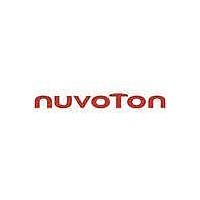NUC130LE3CN Nuvoton Technology Corporation of America, NUC130LE3CN Datasheet - Page 385

NUC130LE3CN
Manufacturer Part Number
NUC130LE3CN
Description
IC MCU 32BIT 128KB FLASH 48LQFP
Manufacturer
Nuvoton Technology Corporation of America
Series
NuMicro™ NUC100r
Specifications of NUC130LE3CN
Core Processor
ARM Cortex-M0
Core Size
32-Bit
Speed
50MHz
Connectivity
CAN, I²C, IrDA, LIN, SPI, UART/USART
Peripherals
Brown-out Detect/Reset, DMA, I²S, POR, PWM, WDT
Number Of I /o
35
Program Memory Size
128KB (128K x 8)
Program Memory Type
FLASH
Eeprom Size
-
Ram Size
16K x 8
Voltage - Supply (vcc/vdd)
2.5 V ~ 5.5 V
Data Converters
A/D 8x12b
Oscillator Type
Internal
Operating Temperature
-40°C ~ 85°C
Package / Case
48-LQFP
Lead Free Status / Rohs Status
Lead free / RoHS Compliant
Available stocks
Company
Part Number
Manufacturer
Quantity
Price
Company:
Part Number:
NUC130LE3CN
Manufacturer:
Nuvoton Technology Corporation of America
Quantity:
10 000
Part Number:
NUC130LE3CN
Manufacturer:
NUVOTON
Quantity:
20 000
- Current page: 385 of 571
- Download datasheet (5Mb)
NuMicro™ NUC130/NUC140 Technical Reference Manual
Figure 5-84 Propagation Time Segment
In this example, both nodes A and B are transmitters, performing an arbitration for the CAN bus.
Node A has sent its Start of Frame bit less than one bit time earlier than node B, therefore node B
has synchronized itself to the received edge from recessive to dominant. Since node B has
received this edge delay (A_to_B) after it has been transmitted, B’s bit timing segments are
shifted with respect to A. Node B sends an identifier with higher priority and so it will win the
arbitration at a specific identifier bit when it transmits a dominant bit while node A transmits a
recessive bit. The dominant bit transmitted by node B will arrive at node A after the delay
(B_to_A).
Due to oscillator tolerances, the actual position of node A’s Sample Point can be anywhere inside
the nominal range of node A’s Phase Buffer Segments, so the bit transmitted by node B must
arrive at node A before the start of Phase_Seg1. This condition defines the length of Prop_Seg.
If the edge from recessive to dominant transmitted by node B arrives at node A after the start of
Phase_Seg1, it can happen that node A samples a recessive bit instead of a dominant bit,
resulting in a bit error and the destruction of the current frame by an error flag.
The error occurs only when two nodes arbitrate for the CAN bus that have oscillators of opposite
ends of the tolerance range and that are separated by a long bus line. This is an example of a
minor error in the bit timing configuration (Prop_Seg to short) that causes sporadic bus errors.
Some CAN implementations provide an optional 3 Sample Mode but the C_CAN does not. In this
mode, the CAN bus input signal passes a digital low-pass filter, using three samples and a
majority logic to determine the valid bit value. This results in an additional input delay of 1 tq,
requiring a longer Prop_Seg.
5.13.6.10.3 Phase Buffer Segments and Synchronization
The Phase Buffer Segments (Phase_Seg1 and Phase_Seg2) and the Synchronization Jump
Width (SJW) are used to compensate for the oscillator tolerance. The Phase Buffer Segments
may be lengthened or shortened by synchronization.
Publication Release Date: June 14, 2011
- 385 -
Revision V2.01
Related parts for NUC130LE3CN
Image
Part Number
Description
Manufacturer
Datasheet
Request
R

Part Number:
Description:
Manufacturer:
Nuvoton Technology Corporation of America
Datasheet:

Part Number:
Description:
Manufacturer:
Nuvoton Technology Corporation of America
Datasheet:

Part Number:
Description:
Manufacturer:
Nuvoton Technology Corporation of America
Datasheet:

Part Number:
Description:
Manufacturer:
Nuvoton Technology Corporation of America
Datasheet:

Part Number:
Description:
Manufacturer:
Nuvoton Technology Corporation of America
Datasheet:

Part Number:
Description:
Manufacturer:
Nuvoton Technology Corporation of America
Datasheet:

Part Number:
Description:
Manufacturer:
Nuvoton Technology Corporation of America
Datasheet:











